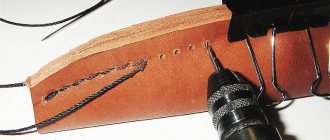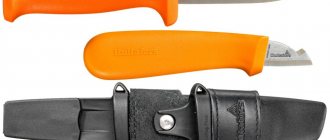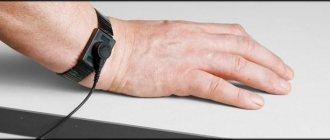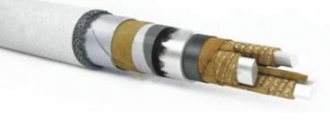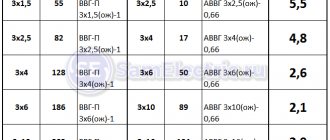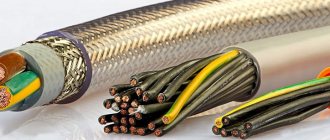The first question asked by those who previously made do with ordinary construction or even office knives is whether an electrician’s knife with a heel is really necessary to such an extent that electrical installation work cannot be performed without it?
Many specialists have worked and are working without it for decades and at the same time competently perform all electrical work. For example, some even specifically use a non-sharpened knife to longitudinally cut the insulation between the cores. This method may be suitable for cables with a soft rubber or vinyl sheath.
The heel does not provide significant savings in operating speed. Of course, the cleaning process is a little faster, but it’s impossible to say that the work is done 2 times faster, in the same amount of time. The most important factor here is the skill of the performer and his experience. A professional should be able to clean with anything, be it a construction knife or side cutters. At the same time, do it efficiently and quickly.
Another question is that a professional must have such a dielectric tool in his kit, but what does it give to the average person?
The most important advantages of this knife:
- comfort at work
- reliable insulation of the handle, in case someone accidentally turns on the machine and voltage appears on the cable (up to 1000 Volts)
- safe removal of insulation without “jambs”, cuts and scuffs, even if you are an amateur and are using it for the first time in your life
This knife is equally suitable for those who are engaged in both purely electrical work and complex repairs, without sufficient experience in cable cutting.
Stripping GOST and TU cables
Another point that should not be forgotten is that the knife with a heel is intended primarily for flat cables of the VVGng-P type. Of course, craftsmen can clean anything with them, but the amenities there will be completely different.
When stripping a round cable, using such a device is dangerous. For brands like NYM, there are more convenient and specially designed tools for this purpose.
Moreover, when using a cable manufactured according to technical specifications (TU), and not according to GOST, the insulation will be removed faster and easier. The insulation of the cable according to GOST is much thicker, it fits more tightly to the cores and is more difficult to work with.
Be sure to wear gloves when working here; without them, it could result in injury.
Therefore, if a knife with a heel does not remove insulation well, do not rush to be disappointed in it, maybe you just happen to have a high-quality cable.
Some recommend stripping the ends of such a cable in advance, even before inserting it into a distribution board or junction box.
By the way, in a similar indirect way you can find out what kind of TU or GOST cable you have. Unless, of course, you are sure that the knife is not dull, and you have tested it before on other wires.
Let's take a closer look at the main manufacturers. They are not much different from each other, but still have their pros and cons.
The need to use special tools
To connect one socket or switch in an apartment, it is not necessary to buy professional equipment. You can strip a piece of wire with a regular kitchen knife. However, if there is a large-scale repair with a complete update of the electrical wiring system, then it is impossible to do without specialized devices.
The number of contacts that must be cleaned when repairing a house with an area of 100 square meters. m can reach thousands. Carrying out such work without specialized devices is an unreasonable waste of time and effort.
A modern room requires the installation of many sockets, switches, panels, junction boxes and lighting fixtures.
In addition, stripping insulation without professional wire stripping tools is fraught with negative consequences:
- there is a high risk of cable damage, which reduces the safety of electrical wiring;
- cutting the conductor leads to a decrease in the cross-section of the wire, resulting in a break or burning at the junction;
- if cut carelessly, the damaged wire may break when bent.
In high-frequency systems with alternating current, the situation is complicated by the appearance of the skin effect - the current is distributed unevenly, but mainly in the surface layer of the conductor. In such wires, any minor defect in the core can damage the equipment.
You can carefully scrape off the insulation with a knife, but the work will take a lot of time. And if you need to prepare a lot of cables, then mistakes are inevitable - it will not be possible to quickly make a large number of high-precision cuts
When it comes to significant volumes of work, it is better not to take risks and use special devices. Damage to the conductor can cause a fire, cause equipment failure, or cause electric shock.
Chinese red knife LS-55
Previously, this knife was not produced under any brand - KVT, aka a replica of the first generation Knipex, Shtok and others. Today, a similar tool can be bought at bazaars and Chinese online stores AliExpress. Other companies switched to a different design. True, some are sure that KVT and “China” are still the same thing, only KVT is twice as expensive.
Many other tools still have the shape of the handle of this knife. It is completely plastic and does not have rubberized inserts. There is a slot at the end of the handle for installing and storing a protective cover.
This is a very original and convenient solution so as not to lose it during work and not look for it later. Other more expensive brands lack this.
If you have a large palm, then the knife may be really small, since it has the shortest handle length among other copies. However, when working in small cabinets, this can be a significant advantage.
The blade is not straight and there is a slight slope. The heel is made quite well:
- teardrop-shaped
- not big
- edges are neatly processed
- good welding
One of the significant disadvantages is that you can often end up with a dull blade. With such a blade it is very difficult to make the first cut. The insulation is crumpled more than it is cut. To facilitate this process, you can use pliers, or even better, thin-nose pliers.
This will allow you to securely hold the cable, slightly lift the outer insulation and, most importantly, remove your hand from the area where the knife could possibly hit when it slips.
Crimp the end of the cable with pliers and place the heel under the outer sheath.
The main thing is to make the initial cut, and then the knife goes faster. It’s easier and safer to make a cut “on your own.” But when working “for himself”, he usually chews insulation. To make it easier, try bending the cable a little, making a small arc.
Of course, it is better to purchase such a knife in person, from a real seller. At the same time, immediately check on the spot how he removes the insulation, taking a piece of cable with him. If you get a dull specimen, you can try to sharpen it yourself. It is not recommended to sharpen electrician's knives with a heel using an engraver or a drill with an attachment.
You can easily damage the tool and overheat the edge, especially at high speeds. It is better to use diamond files and sharpen them on sharpening stones. Of course, sharpening near the heel is not very convenient, but with skill it will work out.
The blade on the outside, which you use to cut away from you, is sharpened with any piece of wood like a chisel. And the internal one - with the help of triangular ones. If you really have no options, then you can get by with automotive sandpaper with a grit of 2500-3000. The whole thing is completed with a belt and goyim paste.
In a similar way, you can correct and sharpen more expensive brands, the same Knipex, if it has become dull over time.
The most important advantage of this knife is its favorable price-quality ratio. It is the cheapest and if you only do electrical work in your apartment or home, then this is the best choice. He will work out his money 100%. The main thing is to check the sharpening. Many professionals still use such knives and have no plans to switch to knipex knives.
How to choose a stripper
Let's consider some general selection criteria: design, price, characteristics, manufacturer, functionality.
Choosing a suitable design
Household tools
If the device is purchased for home use and will be used only periodically, it is better to choose something cheaper and simpler, with the ability to strip the ends, up to 6 sq. mm. High performance cannot be achieved with them, but the user does not have such a goal.
Semi-automatic
Purchasing a semi-automatic puller would be quite justified for everyday use. Even professionals will not neglect such models. Working with them is much more convenient than with simple hand-held devices and things move faster. The average cost of semi-automatic machines fluctuates around 1000 rubles. Deviations in the direction of increase can be quite significant.
Automatic strippers
Professionals whose earnings directly depend on the quality and capabilities of equipment should pay attention to automatic devices. Work with such a device progresses very quickly; undercutting of cores is excluded. Using the machine, you can remove outer shells of round and rectangular sections and remove polymer coatings from all cores at once. You don't need any skills to do this. You just need to insert the cable into the jaws of the device and squeeze the handles.
Tabletop machines
Such devices are designed for workshops involved in assembling electronic equipment. Such an electric machine may have program control. The following set of operations is common for them:
- cutting of trains;
- removing the shell to a specified length;
- crimping (crimping) tips.
At the output, the operator receives ready-made assembly units for assembling circuits. By type of drive, machines can be electric and pneumatic, by size and method of installation - desktop and stationary. The photo shows a desktop automatic wire cutting and stripping machine ZDBX-1 From the Junquan company from Hong Kong.
Choice by price
The price range depends on the brand and functionality. The simplest device that performs only the basic operation is quite affordable. Its purchase will cost on average from 100 to 400 rubles, depending on the brand and quality. However, among hand-made products there are quite expensive ones, almost the same cost as automatic machines. For example, KVT WS-20 Voltmaster.
On the contrary, some models of automatic machines do not exceed the cost of manual devices, such as Fit 60025. There are also very expensive automatic machines, from 8,000 to 10,000 rubles. As a rule, these are popular models from world brands, multifunctional, made of high-quality materials.
Selection by functionality
Regardless of the design, strippers can be single or multifunctional. This is perhaps the most important thing that you simply need to pay attention to. The cheapest models can only strip the ends, such as the Stanley 0-84-010. It is much more convenient to work with a multifunctional device that can not only strip the ends, but also cut the cable. The entire complex of operations will take no more than 15 seconds.
But that's not all. Folding like a case, mechanical models allow you to cut the cores, quickly strip the ends using samples of different diameters, and quickly remove the outer insulation. For this purpose, a disk knife, adjustable in height, is mounted at one of the ends of the product. The whole process is carried out as follows:
- The end of the cable must be placed on a knife so that the cut of the outer sheath is visible.
- Then use the adjustment key to raise the knife so that it cuts into the cable to the thickness of the coating, but no more.
- After which the cable is pulled along the knife blade, cutting the polymer in the longitudinal direction.
- The cut material is cut using a special selection of a multifunctional knife.
Fast, accurate, convenient. An example of such devices is the KBT WS-09 pocket stripper. It costs on average 800 rubles, i.e. Slightly cheaper than some semi-automatic products.
The KBT WS-05 model has even wider functionality. To the above-listed capabilities of the KBT WS-09 model, the functions of a screwdriver are added; two double-sided interchangeable bits are stored in special clamps for flat and Phillips screwdrivers of different sizes. They are inserted into a special socket at the end of the device. For tight fixation in the seat, the bit is “pressed” until it clicks.
Now you can cut and strip the end of the wire with one tool, clamp it in the terminal block, using the stripper as a screwdriver. In addition, with this “screwdriver” you can check the presence of voltage in the assembled circuit. For this purpose, a special contact plate and an LED lamp are provided on the body of the model. We lean the “tip” of the screwdriver against the conductor and touch the plate with our thumb. Based on the reaction of the LED, we determine whether work can continue or the line should be de-energized.
Important! In order to protect against electric shock, electrical installation work should only be carried out when there is no voltage in the network.
Simply put, before you go anywhere with a screwdriver, you should turn off the power to the electrical wiring.
In semi-automatic and automatic products, versatility is ensured by the presence of the following functions:
- cable cutting;
- automatic determination of core cross-section;
- removing the outer shell;
- stripping insulation from a multi-core cable in one step;
- crimping (crimping) tips.
This set of functions is very convenient when disconnecting cables in wiring closets.
KVT NMI-01
Here it must be said right away that you can find a lot of knives with a similar design and handle shape. In fact, they are produced by the same plant, although they have different brand names:
- KVT
- Haupa
- Stock
- Neo
Therefore, if you are thinking about buying such a knife, then you need to choose the cheapest one. The heel, blade, handle are practically no different here.
The heel itself, due to its very large size, is not very convenient when stripping cables of minimum cross-sections - 2 * 1.5; 3*1.5; 2*2.5. The stripping speed also suffers from this.
For such small wires you even have to resort to the services of a simple construction knife. The insulation is cut at the very beginning of the cable, and only then, in order not to damage the cores, it is simply torn with the effort of one hand. But the question is, why did you buy such a knife?
Moreover, not every cable can be easily broken. For example, with TU-shny, where the insulation is something like heat shrinkage, such a trick may not succeed.
It is also very important to check the quality of the weld on the heel. When stripping a rigid cable with hardened insulation, it can actually break off.
This can happen if your heel gets caught in the cable, the knife itself tilts to the side at an angle, and you still try to remove the insulation with force. Welding it back will be problematic due to the material of the blade.
Often there is a defect in the form of asymmetry relative to the tip of the blade. It can actually be shifted to the right or left.
Most problems with the heel are solved by grinding it down to smaller sizes and giving it a teardrop shape. Just make sure the welding is secure before doing this. The inscription on the handle of the KVT knife is erased very quickly, which indicates the possibility of applying any name at all to this tool.
Rating of quality strippers for removing insulation
Inexpensive manual models
The TOP 10 best insulation strippers are manual, budget devices that are easy to use and have limited functionality.
5.Stayer 2265-17
A small, simple tool that looks like pliers. The jaws have a number of holes with cutting edges, diameters 0.6, 0.8, 1.0, 1.3, 1.6, 2.0, 2.6 mm. The stripping process is simple. The core is inserted into a half-hole of a suitable diameter in one of the jaws (lower). The handles are then squeezed (like pliers) until they are completely closed. With several circular movements around the circumference of the core, the insulation is cut and tightened.
The area of the jaws at the base of the handles has a sharp sharpening for cutting wires (replaces side cutters). The handles themselves have protective plastic removable insulation. The jaws have holes for forming loops on the cores and a hole for cutting M3 screws. The total length of the device is 170 mm. The average price is 193 rubles.
Stayer 2265-17
Advantages:
- very affordable price;
- simple design;
- additional function of side cutters.
Flaws:
- there is no function of longitudinal cutting of the outer sheath of the cable;
- the cutting holes are marked with millimeters in diameter, and the sections will have to be calculated independently;
- the calculated sections do not coincide with the real ones, the cutting holes for the cable have to be selected “by eye”.
4.Zubr 22666-26
Manual insulation puller made in Russia. The appearance and structure differ little from the previous sample. The range of functions has been slightly expanded:
- pliers;
- shell remover;
- hole for preparing loops;
- devices for cutting M3 screws.
All listed functions are written on the packaging. The side cutter function is not mentioned, but it is there. Stripping the ends is performed in the same way as in the previous device. Overall, this is a simple, sturdy device that gets the job done. The average price is 212 rubles.
Bison 22666-26
Advantages:
- inexpensive;
- high-quality assembly;
- easy to use.
Flaws:
- the screw cutter function does not justify itself;
- The diameter of stripping holes for conductors of different sections is determined “by eye”.
3.Stock KE-6 26
A tool similar to the previous two from the Russian company Shtok. The device and set of functions are the same, with a few exceptions. Insulating plastic handles are made with stops that prevent the installer's hand from slipping onto a non-insulated surface, therefore, it is intended for professional use. Its average price is 261 rubles.
Rod KE-6 26
Advantages:
- affordable price;
- comfortable insulating handles;
- set of necessary functions.
Flaws:
- unnecessary screw cutter function;
- marking wire diameters instead of cross-section.
2.Fit 60025
Canadian device. In addition to the main one, it has the additional function of cutters (or rather, side cutters). Unlike previous options, there is no need to pull the wires through a calibrated hole. It is enough to insert the wires into a recess of suitable diameter and sharply squeeze the handles of the device. The jaws with cutting edges close, trim and move the shell in different directions. Part of the sponges at the very base acts as nippers. There are no other functions. The average cost is 330 rubles.
Fit 60025
Advantages:
- affordable price;
- the operation is performed in one motion.
Flaws:
- total of 4 cutting sockets;
- The “nippers” are weak.
1.Stanley 0-84-075
The simplest stripper of those demonstrated by our TOP 10 best strippers of 2022. It also looks like pliers or pincers, but the jaws are not designed for gripping. Their tips are equipped with triangular recesses with cutting edges. For a comfortable grip, two-component insulated handles are provided. The inner part is made of plastic, the outer part is rubberized so that wet fingers do not slip towards the uninsulated part of the instrument. The average price is 459 rubles.
Stanley 0-84-075
Advantages:
- ease of use;
- high-quality assembly;
- trouble-free operation;
- affordable price.
Flaws:
- not identified.
Multifunctional strippers for professionals
5.Stayer TS-X
Automatic puller with extended functionality. Excellent cable cutting. With one click on the handle, it easily removes the outer sheath of round and rectangular cross-section from one, two or three conductors at the same time. Using devices on the inside of the handles, you can crimp several types of tips. Two-component insulating handles with stops. The tool is intended for professional use. The average price is 873 rubles.
Stayer TS-X
Advantages:
- multifunctionality;
- ease of use;
- no special skills required;
- reasonable price.
Flaws:
- not identified.
4.Zubr Expert 22669
Professional multifunctional machine developed in Russia. Made in Taiwan. Easily strips cables from 0.05 sq. mm to 8.0 sq. mm in diameter, of various purposes and shapes:
- power;
- telephone;
- coaxial;
- round and flat;
- twisted pair
Using wide jaws, the device easily copes with cutting and stripping two and three wires at the same time, crimps insulated and non-insulated ferrules, and automotive terminals. Two-component insulating removable handles prevent the tool from slipping in wet fingers and protects against electric shock. The average price is 1249 rubles.
Bison Expert 22669
Advantages:
- high-quality assembly, no backlash;
- multifunctionality;
- trouble-free operation.
Flaws:
- does not cope well with rubber casings.
3.KW-WS-20 Volt Master
Professional multifunctional pocket stripper. Performs five functions:
- cleans ends with a cross-section from 0.5 to 6.0 sq. mm;
- cuts outer shells with a diameter of up to 13mm in the transverse direction;
- cuts the shell in the longitudinal direction on conductors with a diameter of up to 5 mm;
- removes insulation from the RG-6/59 antenna cable;
- equipped with a built-in voltage detector.
Convenient to use. Popular among professional electricians, despite the fact that it is manual. The end blade for longitudinal cutting of the outer shell is conveniently located at an angle to the axis of the device. The voltage indicator is turned on by a button on the case and brought to the wire. If there is voltage, it gives a sound signal, duplicated by the LED signal. The average price is 1359 rubles.
KVT-WS-20 Volt Master
Advantages:
- multifunctional;
- lasting;
- compact;
- built-in voltage indicator.
Flaws:
- manual.
2.Stanley Fat Max FMHTO-96230
Automatic stripping pliers. American brand, made in Taiwan. The assembly is high quality, without any backlash. Easily “snacks” material with a cross-section of up to 10 sq. mm, strips the ends with a cross-section from 0.8 to 2.6 sq. mm. Crimps insulated lugs from 0.5 to 6.0 sq. mm. Protective covers for handles are made of two-component material (plastic + rubber), and therefore do not slip in your hands. A good professional tool for long-term intensive use. The average price is 1961 rubles.
Stanley Fat Max FMHTO-96230
Advantages:
- well assembled;
- multifunctional;
- convenient to use.
Flaws:
- not identified.
Knipex KN 9855
Knipex is one of the most expensive specimens.
In terms of functionality, it differs little from its cheaper counterparts, but it has one thing for which you actually overpay - its branding. When buying any of the knives, at first glance it is not immediately possible to distinguish which brand is in front of you.
When purchasing Knipex, you will immediately understand that this is the one in front of you. The style and design makes itself felt and is difficult to confuse with others. This tool has very little defects and you can work with such a knife for many years. You cannot find the grossest defects inherent in other manufacturers. The heel is always welded evenly and securely.
Convenient teardrop shape. It is to its size and shape that all other brands are adjusted when they are going to modify them. Even if any mistakes are discovered, it is easiest to exchange the Knipex tool from official suppliers.
The only inconvenience may be caused by the blade, which will eventually become dull. Especially if you use it to cut insulation like construction knives.
You can fix it using the methods described above. After which, he will again serve you faithfully.
True, certain problems may arise due to the shape of the knife. Initially, the bead on the handle will interfere, but if desired, it can be ground off a little.
But the most difficult thing is the plastic blade protection, which is located on top and makes it difficult to maintain the factory angle. If you need this protection, you will have to change the angle a little. This will not stop the knife from cutting, the main thing is that the blade is sharp. If you want to keep the “factory settings”, you can grind off a couple of millimeters of plastic.
Most often, the outer side of the blade deteriorates, the one that is intended for stripping away from itself. This is due to the fact that if you work carelessly inside electrical panels, the knife can break off and hit some obstacle with this side.
Well, in general, this is the best electrician’s knife of all those presented, especially for stripping rigid and GOST cables.
Basic parameters of an electrician's knife
The electrician's knife must have the characteristics shown in the table.
| Component or indicator | Requirements and parameters |
| Lever | Comfortable, non-slip with a secure grip. It can be insulated, allowing you to work with non-de-energized wires. In this case, it should contain information about what voltage is permissible for the tool. |
| Blade | Size 28-100 mm, width 18-23 mm. Can be straight or curved, with or without a heel. There are blades for different wire diameters. |
| Blade | Well sharpened, perhaps on both sides, but not too sharp, without any rough edges. If there are nicks, they must be eliminated so that the wire strands are not damaged during operation. |
| Heel | It has a rounded shape, attached perpendicular to the blade on the tip. It should be smooth, slightly convex, and the size should correspond to the cross-section of the cable. Not available in all types of electrician's knives. |
| Total value | 155-220 mm |
| Weight | Up to 125 g |
| Blade material | Medical steel, stainless, carbon, hardness 51-53 HRC. May be coated with titanium nitrite, referred to as TIN. |
| Handle material | Carbon fiber, wood, rubber or plastic. The latter can be ordinary or special - it does not allow electric current to pass through. |
| Adjusting the cutting diameter | Some models have a special screw for this purpose, which can be used to set the depth of the cut. It helps protect the cable from damage. But not all instruments have the device. |
Sata
The design shape is very similar to the KVT NMI-01, but slightly smaller in size. When purchasing not in person in a store, but through the mail by parcel, you may encounter problems:
- crooked heel
- Moreover, it may not be completely welded to the knife. There are clearly visible gaps at the beginning and end of welding.
- poor sharpening and, as a result, poor quality removal of insulation
Therefore, with this brand you need to rely more on luck. There are no guarantees whether you will be lucky or not with quality. And the price is twice as high as that of a red Chinese knife.
Choosing a stripping method for different wires
The complexity of removing insulation is largely determined by the type of wire. When choosing a tool, you should consider the cable features:
- Coaxial wire. When removing double insulation, work is carried out in two stages. The top layer can be removed thermally, and the bottom layer can be removed using a stripper. The cores of such a cable are very fragile and thin, so they are easily damaged.
- Cable with fluoroplastic coating. Heat-resistant insulation that can only be removed mechanically. An electrician's knife or stripper will do.
- Enameled wire. If the cross-section is less than 0.2 sq. mm, then you need to resort to the thermochemical method using a soldering iron and vinyl chloride tape. The wire is placed on the tape and passed along the cable with a soldering iron - the released chlorine promotes the “removal” of the enamel sheath from the wire.
When choosing a tool, you need to take into account the diameter of the wire the device is designed for, as well as the material used to make the handle.
The cable cutter is universal in terms of size. But pliers, pincers, manual and semi-automatic strippers are limited by their gripping range
If it is necessary to process electrical cables, it is necessary to select strippers with a handle made of dielectric material.
The coating protects against voltages up to 1000 W.
N.W.S.
The main difference here is the original handle. Namely, its curved shape and special indentations for fingers. If you have worked with other brands before, you will feel discomfort at first. It's a matter of habit here.
The handle is quite long and it is not very convenient to use it in narrow and compact cabinets. Unfortunately, there are no company inscriptions indicating the manufacturer's brand. You can easily run into some kind of fake, where any Chinese will write Made in Germany.
The heel, like the Knipex knife, has a slope and is small in size. This makes it easier to work with small cross-section cables. But the quality of the steel raises questions. Jagged edges may appear if the blade hits the copper core of the cable during the stripping process.
But for the money, taking into account the German manufacturer, this is not a bad choice for a quality knife.
Nippers or pliers: nuances of use
A proven tool that works to break. The working principle of the cutters is simple. Using a screw, select the desired diameter of the wire, then grab the cable, twist it a little in a circle and tighten the insulating coating.
When setting up the pliers, choose a grip width slightly larger than the cable cross-section. This will protect the conductor from scratches while removing the protective layer.
Expensive models of tongs are made with insulated handles made of high-quality steel. Some pliers strip even the thinnest wires without breaking.
Additional advantages of wire cutters include:
- reliability;
- durability;
- ability to work in hard-to-reach areas;
- stripping live wires.
Disadvantages of wire cutters: the inability to choose the length of removal of the insulating layer, the need to constantly reconfigure the screw when stripping wires of different diameters.
Jokari
The knife has a simple and uncomplicated shape. A similar handle is very common in Weicon, Haupa and some NWS. Made of homogeneous material, without comfortable rubberized inserts.
Has a huge cap protecting the blade. The heel is of an original shape and medium in size, and also has a slope. It is boat-shaped and raised at the ends.
Made so that it can be cut into the insulation directly from the middle of the cable. Sometimes this is simply necessary.
It removes insulation similarly to other knives and at the same time has a price tag that is several times more expensive, often even more than that of Knipex. It's up to you to decide whether it's worth paying extra money. When you have a choice, you can look at more attractive design models.
COMPARISON TABLE
| Brand | Heel | Pen | Price |
| Red LS-55 | Small | Plastic | 300 rubles |
| KVT NMI-01 | Big | Two-component | 1000 rubles |
| Knipex KN 9855 | Small | Two-component | 3100 rubles |
| Sata | Big | Two-component | 800 rubles |
| N.W.S. | Small | Two-component | 2200 rubles |
| Jokari | Small | Plastic | 3300 rubles |
You can view current prices today and choose the electrician’s knife you need here.
How to make an electrician's knife with your own hands
You can make your own electrician's knife from two blades of stationery knives or a small piece of metal, since the working part of the tool should be small. In the first case, the sequence of actions is as follows:
- You need to cut out a rectangular piece on the blade of a stationery knife to form a fairly narrow protruding part (spike).
- An oval or round heel of the required diameter is cut out of another blade, and a line of contact with the tenon (slot) is drawn in it.
- Both parts are connected by soldering.
- The outer part of the heel needs to be sanded so that the surface becomes smooth and the shape is slightly convex.
- All that remains is to cut the linings out of wood or plastic to size and attach them using epoxy glue.
- It is better to sharpen the blade only from the outside and guide it away from you while working.
This primitive knife can be used if you need to repair the wiring at home, just be sure to turn off the power first.
A more advanced tool is obtained in another way:
- You need to take a strip of carbon steel 3-5 mm thick and make a drawing of a curved blade along with the heel on it.
- The workpiece is cut with a grinder or on a machine.
- Excess metal at the junction of the base of the blade and the heel is thinned using the same devices so that the last part stands out.
- Then you need to sharpen the blades (one or both).
- The heel is also sanded until smooth; it should be slightly convex, but without jagged edges.
- Handle linings made of wood, plastic, or rubber hose are attached to the blade.
The last stage is performed using epoxy glue, but for reliability it is supplemented with fasteners. For them, you will need to drill holes in the shank of the blade and on the linings themselves.
We recommend reading about how to choose a carving knife for working in the kitchen. From the article you will learn about the characteristics and purpose of a cutting knife, its varieties, cost, and rules for processing meat knives. And here is more information about the pros and cons of electric knives.
There are many tools for removing protection from cables, and a specialist should only choose a good quality factory cutter. If you need to repair the wiring at home yourself, you can buy an inexpensive product with a heel or make it yourself. The latter is not difficult, and the materials for the knife are quite affordable.
Useful video
Watch this video on how to make an electrician's knife with your own hands:
Similar articles
- Knife handle: depending on size, thickness, how...
What kind of knife handle can be based on the main indicators - thickness, size, method of decoration. How to make a handle for a knife, which drawing is suitable. How to attach a blade to a handle. Is there a knife without a handle? Read more - Switchblade: main types - American, Soviet...
What kind of switchblade is there? What are the most popular types among Russian, Soviet, American manufacturers. Some knives with a secret, some frontal, push-button. Is it a melee weapon or not? What are the advantages of an automatic switchblade. Read more
- How to make a throwing knife with your own hands: types...
What are the options for making a throwing knife with your own hands? What types are there (steel, paper, wood). How to make a pattern for a homemade knife. How to calculate blade sizes from drawings. How to make a throwing dagger and stand at home. Read more
- Electric knife: what kind is used for fish, meat, bread, slicing...
What is an electric knife and why is it used? What is the best electric knife for fish, meat, bread, slicing, sausage. Which one is used for wax. Why are electric knives needed in medicine? What brands produce electric knives for the kitchen. Read more
- Types of knives: what are there for kitchen, table...
Main types of knives in Europe and Asia. Varieties by affiliation and classification by origin. What are the shapes, what are the parts called, types of triggers and blades. Which ones relate to kitchen, combat, hunting. Read more
